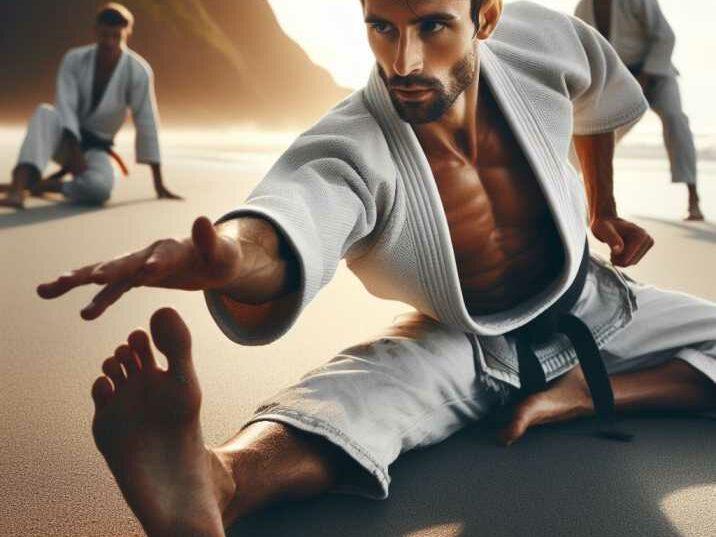Introduction:
Table of Contents
Martial arts have long been revered for their ability to cultivate discipline, strength, and agility. Across the globe, practitioners seek to master various disciplines in pursuit of self-improvement and combat prowess. However, with a plethora of martial arts styles available, choosing the right combination can be a daunting task. In this comprehensive guide, we delve into the intricacies of martial arts to uncover the ultimate martial arts combo for achieving mastery in combat.
1. Understanding Martial Arts: A Brief Overview
Martial arts encompass a diverse range of combat practices originating from different cultures and regions. From the striking techniques of karate to the grappling maneuvers of Brazilian Jiu-Jitsu, each discipline offers unique insights into the art of combat. It is essential to understand the fundamental principles and techniques of each martial art to effectively combine them for optimal performance.
Karate: The Way of the Empty Hand
Karate, originating from Okinawa, Japan, focuses on powerful strikes using the hands, elbows, knees, and feet. Emphasizing discipline and self-control, karate practitioners develop strong stances and precise techniques to deliver devastating blows to their opponents.

Brazilian Jiu-Jitsu: The Art of Ground Fighting
Brazilian Jiu-Jitsu (BJJ) is renowned for its emphasis on ground fighting and submission holds. Originating from Brazil, BJJ practitioners leverage leverage positioning, joint locks, and chokeholds to overcome larger and stronger opponents. With a focus on technique and leverage, BJJ offers a strategic approach to combat.
Muay Thai: The Art of Eight Limbs
Muay Thai, also known as the “Art of Eight Limbs,” hails from Thailand and utilizes punches, kicks, elbows, and knee strikes. Known for its aggressive and relentless fighting style, Muay Thai practitioners develop exceptional striking power and conditioning through rigorous training drills and sparring sessions.
2. The Synergy of Martial Arts: Crafting the Perfect Combination
Combining multiple martial arts disciplines allows practitioners to leverage the strengths of each style while mitigating their weaknesses. By integrating striking, grappling, and submission techniques, practitioners can adapt to a variety of combat scenarios and opponents. The following martial arts combo offers a balanced approach to combat mastery:
Karate + Brazilian Jiu-Jitsu: The Dynamic Duo
Combining the striking prowess of karate with the ground fighting techniques of Brazilian Jiu-Jitsu creates a well-rounded martial artist capable of excelling in both stand-up and ground combat. This combination enables practitioners to seamlessly transition between striking and grappling, ensuring versatility and adaptability in any situation.
Muay Thai + Wrestling: The Power Pairing
Integrating the devastating strikes of Muay Thai with the takedown and control techniques of wrestling produces a formidable martial artist adept at both striking and grappling exchanges. This combination emphasizes aggressive striking coupled with the ability to dictate the pace of the fight through effective clinch work and takedowns.

3. Exploring Additional Martial Arts Combinations
While the karate + Brazilian Jiu-Jitsu and Muay Thai + wrestling combos offer exceptional synergy, there are other combinations worth exploring for those seeking alternative approaches to combat mastery.
Taekwondo + Judo: The Art of Precision and Throws
Combining the dynamic kicks of Taekwondo with the throwing techniques of Judo creates a martial artist adept at both long-range striking and close-quarters combat. Taekwondo’s emphasis on speed and precision complements Judo’s focus on leverage and control, resulting in a versatile combat style suitable for a variety of opponents.
Boxing + Capoeira: The Fusion of Power and Agility
Integrating the explosive punching of boxing with the acrobatic movements of Capoeira yields a unique martial arts combo that emphasizes fluidity and creativity in combat. Boxing provides solid fundamentals in punching and footwork, while Capoeira adds dynamic kicks, spins, and sweeps, allowing practitioners to dazzle opponents with a blend of power and agility.
Krav Maga + Eskrima: The Practical and Tactical Approach
Combining the practical self-defense techniques of Krav Maga with the weapon-based tactics of Eskrima results in a comprehensive martial arts combo geared towards real-world combat scenarios. Krav Maga’s focus on instinctive movements and efficient strikes pairs seamlessly with Eskrima’s use of sticks, knives, and improvised weapons, providing practitioners with a versatile skill set for self-defense.
4. Choosing the Right Martial Arts Combo for You
Selecting the best martial arts combo depends on various factors, including personal preferences, goals, and physical attributes. Consider the following tips to help guide your decision:
- Identify Your Objectives: Determine whether your primary goal is self-defense, fitness, competition, or personal growth to narrow down suitable martial arts combinations.
- Assess Your Abilities: Evaluate your current skill level, physical fitness, and willingness to commit to training to ensure compatibility with your chosen combo.
- Research and Consult: Take the time to research different martial arts styles and consult with experienced instructors to gain insights into which combinations align with your interests and aspirations.
- Trial and Error: Don’t be afraid to experiment with different combinations through trial classes or workshops to find the one that resonates most with you.
5. Understanding the Philosophies Behind Martial Arts Combinations
Beyond the physical techniques, martial arts are deeply rooted in philosophical principles that shape the mindset and approach of practitioners. Understanding these philosophies can provide invaluable insights into the rationale behind different martial arts combinations.
Karate + Brazilian Jiu-Jitsu: Harmony of Hard and Soft
The fusion of karate and Brazilian Jiu-Jitsu embodies the concept of yin and yang, where karate represents the “hard” aspect with its emphasis on striking and aggression, while Brazilian Jiu-Jitsu embodies the “soft” aspect with its focus on leverage, technique, and flow. By combining these seemingly contrasting elements, practitioners achieve a harmonious balance that enables them to adapt to any combat situation with fluidity and efficiency.
Muay Thai + Wrestling: Fusion of Tradition and Modernity
Muay Thai and wrestling represent two distinct martial arts traditions originating from different cultures and historical contexts. Muay Thai, deeply rooted in Thai culture and tradition, emphasizes honor, respect, and discipline, while wrestling, originating from ancient combat sports, embraces innovation, adaptability, and strategy. The fusion of these traditions creates a dynamic synergy that blends the time-honored techniques of Muay Thai with the modern tactics of wrestling, resulting in a comprehensive martial arts combo that honors the past while embracing the future.
6. Exploring the Cultural Significance of Martial Arts Combinations
Martial arts are not just physical disciplines but also cultural expressions that reflect the values, beliefs, and traditions of their respective origins. Delving into the cultural significance of different martial arts combinations can deepen our appreciation for their rich heritage and diversity.
Karate + Brazilian Jiu-Jitsu: East Meets West
The combination of karate and Brazilian Jiu-Jitsu represents a fusion of Eastern and Western martial arts traditions, symbolizing the globalization and cross-cultural exchange prevalent in today’s interconnected world. Karate, with its roots in Japanese martial arts, embodies the disciplined spirit of the East, while Brazilian Jiu-Jitsu, born out of Brazilian innovation and adaptation, reflects the dynamic energy of the West. Together, they form a potent synthesis of tradition and innovation that transcends cultural boundaries and resonates with practitioners worldwide.
Muay Thai + Wrestling: Tradition and Modernity in Harmony
Muay Thai and wrestling each carry deep cultural significance within their respective societies, serving as symbols of national identity, pride, and heritage. Muay Thai, Thailand’s national sport, is steeped in centuries of tradition and ritual, while wrestling, a cornerstone of many cultures and civilizations, has evolved over millennia to reflect changing societal norms and values. The fusion of Muay Thai and wrestling represents a harmonious blend of tradition and modernity, where ancient techniques meet contemporary strategies to create a martial arts combo that honors the past while embracing the future.
7. Harnessing the Mental Benefits of Martial Arts Combinations
In addition to physical prowess, martial arts combinations offer numerous mental and emotional benefits that contribute to overall well-being and personal development. Understanding these benefits can inspire practitioners to delve deeper into their training and unlock their full potential.
Karate + Brazilian Jiu-Jitsu: Cultivating Discipline and Resilience
The combination of karate and Brazilian Jiu-Jitsu instills valuable life skills such as discipline, resilience, and mental fortitude. Through the rigorous training and challenges inherent in both disciplines, practitioners learn to push past their limits, overcome obstacles, and stay focused on their goals. This mental toughness translates beyond the dojo, empowering individuals to tackle challenges in their personal and professional lives with confidence and determination.
Muay Thai + Wrestling: Building Confidence and Self-Esteem
The fusion of Muay Thai and wrestling fosters confidence, self-esteem, and assertiveness in practitioners. As they master the techniques and strategies of both disciplines, individuals develop a sense of self-assurance and empowerment that radiates through every aspect of their lives. Whether in the ring or in everyday interactions, the confidence gained from martial arts training enables practitioners to navigate challenges with poise and assurance.
8. The Role of Martial Arts in Personal Growth and Transformation
Martial arts combinations serve as catalysts for personal growth and transformation, providing individuals with a platform for self-discovery, self-expression, and self-improvement. Through the journey of training and mastery, practitioners undergo profound changes that extend far beyond physical skills.
Karate + Brazilian Jiu-Jitsu: The Path of Self-Discovery
The combination of karate and Brazilian Jiu-Jitsu offers a path of self-discovery and self-awareness, where practitioners delve deep into the intricacies of body and mind. As they explore the nuances of each discipline, individuals uncover hidden strengths, weaknesses, and potentials within themselves, leading to a deeper understanding of who they are and what they are capable of achieving.
Muay Thai + Wrestling: The Journey of Self-Expression
The fusion of Muay Thai and wrestling provides a platform for self-expression and creativity, allowing practitioners to unleash their inner warrior and express themselves authentically through movement and action. Whether through the precision of a well-timed strike or the finesse of a perfectly executed takedown, individuals find liberation and fulfillment in the freedom of martial arts expression.
9. Training Tips for Mastery
Achieving proficiency in a martial arts combo requires dedication, perseverance, and consistent training. Here are some essential tips to maximize your training regimen:
- Consistent Practice: Dedicate regular time to training each martial art component of your chosen combo to develop muscle memory and proficiency.
- Cross-Training: Supplement your primary disciplines with additional training sessions to enhance your overall skill set and combat effectiveness.
- Sparring: Engage in controlled sparring sessions with training partners to test your techniques and adaptability in realistic combat scenarios.
- Physical Conditioning: Prioritize strength, flexibility, and endurance training to optimize your physical attributes for combat performance.
- Seek Guidance: Consult with experienced instructors and coaches to refine your techniques, address weaknesses, and strategize your training approach.
Table of information summarizing the key aspects of each martial arts combination discussed in the article:
| Martial Arts Combo | Primary Techniques | Key Benefits |
|---|---|---|
| Karate + Brazilian Jiu-Jitsu | Striking, Ground Fighting | Versatility, Adaptability, Self-Defense |
| Muay Thai + Wrestling | Striking, Takedowns, Clinch Work | Aggression, Control, Conditioning |
| Taekwondo + Judo | Kicking, Throwing Techniques | Precision, Throws, Close-Quarters Combat |
| Boxing + Capoeira | Punching, Acrobatics | Power, Agility, Creativity |
| Krav Maga + Eskrima | Self-Defense, Weapon Tactics | Practicality, Tactical Approach |
Conclusion:
Our journey through martial arts combinations has revealed a world rich in diversity and potential. From the fusion of karate and Brazilian Jiu-Jitsu to the synthesis of Muay Thai and wrestling, each combination offers a unique path to mastery.
Beyond physical skill, martial arts nurture mental resilience, confidence, and personal growth. They unite practitioners across cultures and generations, bound by shared values of discipline and respect.
As we conclude, let us carry forward the lessons learned and the memories cherished. Embrace the diversity of disciplines, unleash your inner warrior, and embark on your martial arts odyssey. In the pursuit of mastery, there are no limits, only endless horizons waiting to be conquered.
FAQs (Frequently Asked Questions)
1. What is the best martial arts combo for self-defense?
- The combination of karate and Brazilian Jiu-Jitsu offers a balanced approach to self-defense, combining striking and grappling techniques for versatile combat effectiveness.
2. Can I learn multiple martial arts simultaneously?
- Yes, many practitioners choose to train in multiple martial arts disciplines simultaneously to broaden their skill set and combat proficiency.
3. How long does it take to master a martial arts combo?
- Mastery in martial arts is a lifelong journey, with proficiency varying based on individual dedication, training frequency, and natural aptitude.
4. Is it necessary to compete in tournaments to excel in martial arts?
- While tournaments offer valuable opportunities for growth and development, mastery in martial arts can be achieved through consistent training and personal growth, regardless of competitive involvement.
5. Can children learn a martial arts combo effectively?
- Yes, children can effectively learn and benefit from practicing a martial arts combo under the guidance of experienced instructors who tailor training to their age and skill level.


